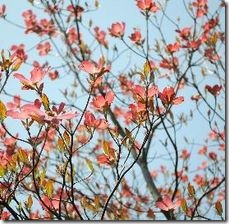The flowering dogwood tree (Cornus florida) is native to the eastern half of the United States and is the Virginia state tree. Although when cultivated the tree grows 15 to 25 feet tall, flowering dogwood trees that occur naturally in wooded areas can get as tall as 40 feet. Because it does not normally grow to a great height when planted as part of a landscape setting, the flowering dogwood makes a practical and decorative addition for most yards.
Appearance
-
The flowering dogwood tree tends to grow more horizontally than vertically, resulting in a tree that is as wide or wider than it is tall. The large, striking flowers on the tree are actually bracts, which look like flowers but are made up of a combination of colored leaves and smaller flowers. The dogwood blooms for several weeks in the early spring, then has dark green leaves throughout the summer. Fruit clusters are bright red and begin to appear in the fall. Also in the fall, the leaves change dramatically, becoming red to reddish purple in color. Its unusual shape makes the dogwood a point of interest even in the winter, when it has no leaves.
Growing
-
Flowering dogwoods grow best in soil that is slightly acidic, with a pH of 5.0 to 6.5. The soil should be deep, rich and well-drained, and either sandy or loamy in character. Since the dogwood occurs naturally in the forest understory, it will grow well in either sun or shade, but too much shade will significantly affect how well it flowers. Also, because it is conditioned to live in sheltered soils, this tree does not do well when planted in areas where the soil is exposed and changes temperature rapidly. It is not drought-tolerant and needs regular watering, especially the first year after planting, if it is to survive. Care should be taken when fertilizing the dogwood, because too much fertilizer can damage it, especially when the tree is young.
Problems
-
Flowering dogwood trees are susceptible to many problems, especially when grown as ornamental yard trees. Dry, hot summers and winters that are unusually cold can stress these trees. Pests that commonly attack flowering dogwoods may become better established in stressed trees. A major concern is the dogwood borer (Synanthedon scitula), a blue-black moth with yellow bands that emerges in early summer to lay its eggs in cracks and joints of the trees. Dogwood is also susceptible to fungus, such as dogwood anthracnose and powdery mildew. Trees should be treated with the appropriate insecticide or fungicide at the first sign of problems.
Fun Facts
-
It is not clear where the name "dogwood" originated from. It is possibly because a species of this tree was used in Europe to make a treatment for mange. It may also be from the early colonists referring to the fruit of the dogwood as worthless "dog berries."


Deprecated: strpos(): Passing null to parameter #1 ($haystack) of type string is deprecated in /home/agriviek8Qv/agriviet.net/public_html/wp-includes/comment-template.php on line 2522